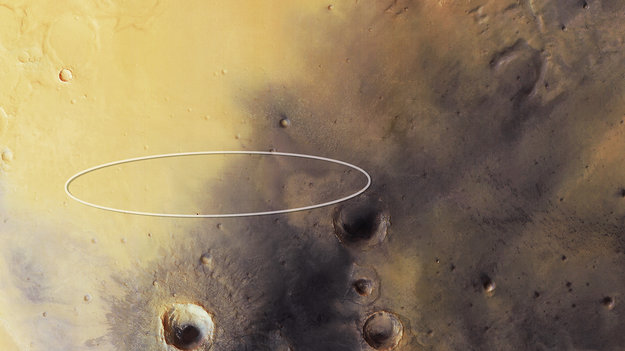The Schiaparelli lander will separate from the TGO orbiter on 16 October 2016. Schiaparelli will land on Mars on 19 October 2016. The Trace Gas Orbiter will remain in orbit around Mars.
———————
Press release by ESA 3 Oct 2016.
http://exploration.esa.int/mars/58307-the-hazards-of-landing-on-mars/
With the launch of ExoMars 2016, ESA is now seeking to join NASA in becoming only the second space power to deliver a lander and complete a successful mission on the Martian surface. (The ill-fated Beagle was an earlier such attempt.) The Schiaparelli entry and descent module of the ExoMars 2016 mission will make a high speed, ballistic entry into the atmosphere.

In the case of Schiaparelli, the landing ellipse measures 100 km by 15 km. Schiaparelli is aiming for Meridiani Planum, a relatively smooth, flat region close to the Martian equator and fairly near the current location of NASA’s Opportunity rover.
Entering the upper atmosphere at a speed of almost 21 600 km/h (6 km/s), a spacecraft typically takes 6 to 7 minutes to reach the surface. First, it has to endure two to three minutes of extreme heating, caused by atmospheric friction. Protected by a heat shield, the craft is able to survive a temperature reaching several thousand degrees Celsius and buffeting by atmospheric shock waves. The spacecraft decelerates rapidly, and by the time it has slowed to around 1700 km/h (0.47 km/s) at an altitude of around 10 km, it is able to deploy a supersonic parachute. A short time later, the speed has slowed sufficiently to allow the heat shield to be jettisoned.
Schiaparelli is unusual by carrying only non-rechargeable batteries, so its active life will be limited to only a few days. This is because its primary objective is to demonstrate entry, descent and landing technologies.
—————————-
The ExoMars programme is a joint endeavour between ESA and the Russian space agency, Roscosmos. So it will be the first Russian success outside Earth orbit. The 2016 mission is composed of the Trace Gas Orbiter (TGO) and landing demonstrator Module Schiaparelli. TGO carries scientific instruments to detect and study atmospheric trace gases, such as methane. Schiaparelli contains sensors to evaluate the lander’s performance as it descends.
The Trace Gas Orbiter will map the sources of methane and other gases on Mars. The TGO will also serve as a telecommunication relay satellite for the NASA rovers and for future landed missions until 2022.
Schiaparelli will measure the wind speed and direction, humidity, pressure and surface temperature, and determine the transparency of the atmosphere. It carries a surface payload, based on the proposed meteorological DREAMS (Dust Characterization, Risk Assessment, and Environment Analyser on the Martian Surface) package, consists of a suite of sensors to measure the wind speed and direction (MetWind), humidity (MetHumi), pressure (MetBaro), surface temperature (MarsTem), the transparency of the atmosphere (Optical Depth Sensor; ODS), and atmospheric electrification (Atmospheric Radiation and Electricity Sensor; MicroARES).
The following image is of a model of Schiaparelli.
———————
ESA TV (http://www.esa.int/esatv/Television) will next screen a 15 minute review of the ExoMars project at
Tue, Oct 11, 2016 | 06:30 – 06:45 GMT
and replay it at
Tue, Oct 11, 2016 | 15:00 – 15:15 GMT


